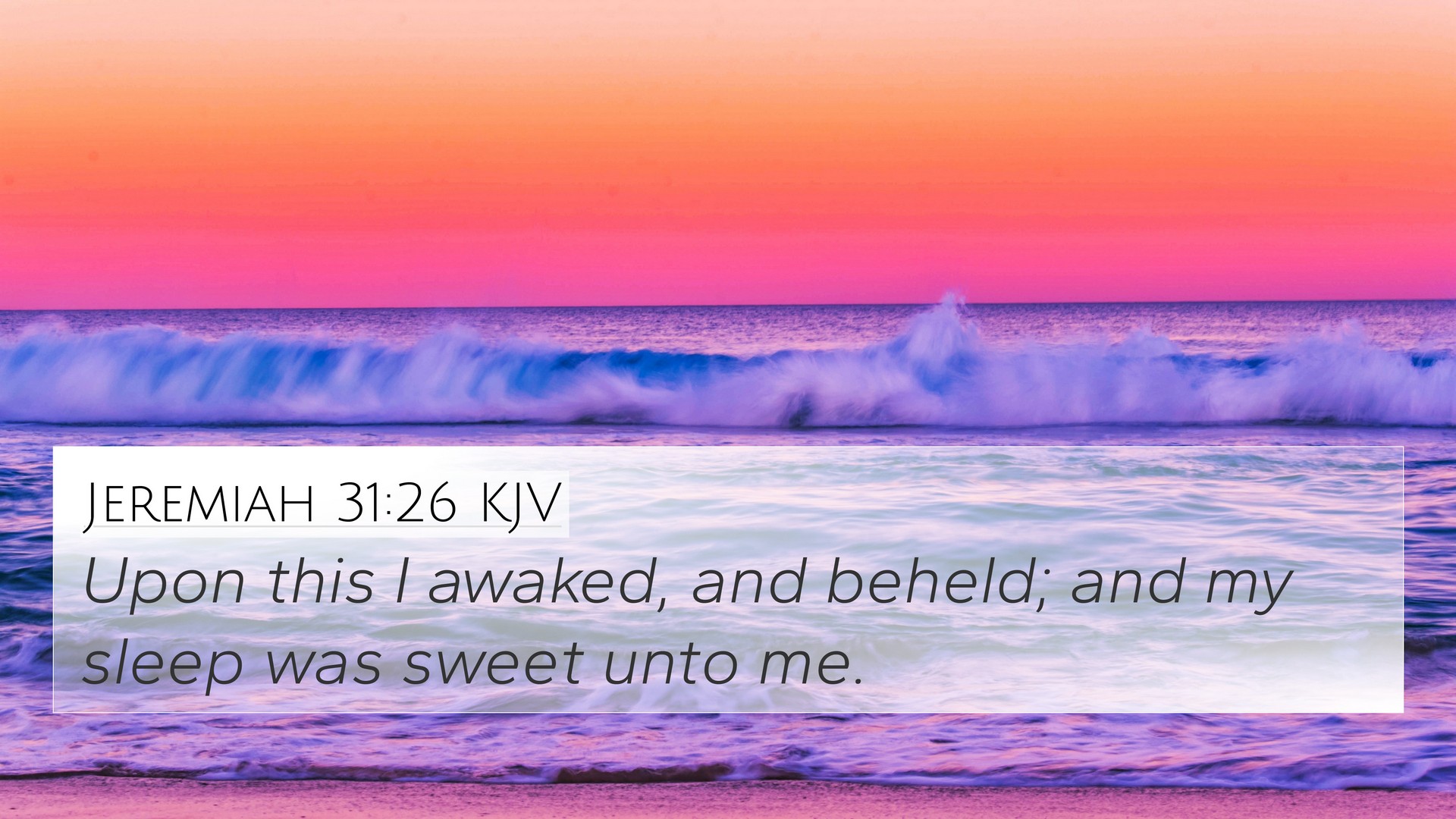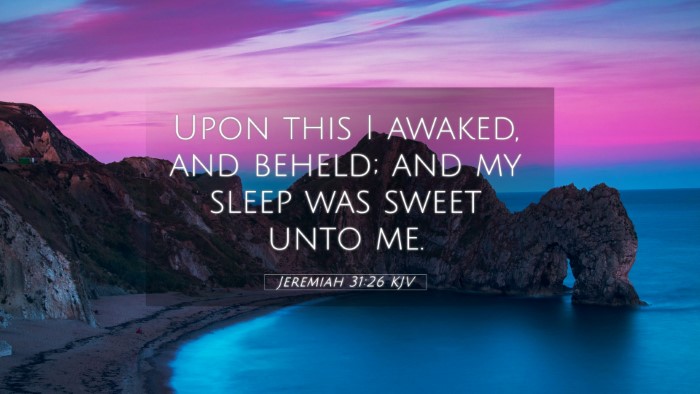Understanding Jeremiah 31:26
Jeremiah 31:26 states, "At this I awoke and looked around. My sleep had been pleasant to me." This verse provides a profound insight into the prophet Jeremiah's experience, illustrating themes of restoration and hope within a dream context. Below is a detailed examination of its meaning drawn from public domain commentaries.
Contextual Overview
The Book of Jeremiah is a prophetic text comprising messages that God conveyed through His prophet Jeremiah during a time of Judah's impending destruction and exile. Jeremiah 31 specifically focuses on the future restoration of Israel. This particular verse signifies a moment of awakening, which can be interpreted both literally and spiritually.
Insights from Commentaries
-
Matthew Henry's Commentary:
Henry interprets this verse as an indication of a moment of revelation. The state of pleasant sleep represents a state of peace that Jeremiah anticipates for Israel. It reflects hope amidst turmoil, suggesting that even in moments of distress, God's promises lead to a restorative awakening.
-
Albert Barnes' Notes:
Barnes focuses on the transitions seen in this chapter, emphasizing that despite the sorrows that Jeremiah proclaims, there is an undercurrent of hope and renewal. The act of waking from sleep speaks of a future when Israel will be rejuvenated, shedding the burdens of their sins.
-
Adam Clarke's Commentary:
Clarke notes that the pleasant dream symbolizes the prophetic vision of peace and restoration God provides. Just as a refreshing dream can rejuvenate the spirit, God’s messages through prophets like Jeremiah aim to do the same for His people, reminding them of His unwavering commitment to their future welfare.
Thematic Analysis
This verse fits into a larger theme throughout the Scriptures regarding God’s intention to restore His people. Key thematic connections include:
- Dreams and Revelations: Just as dreams can serve as divine revelations, Jeremiah’s dream signifies God’s messages of hope.
- Awakening from Spiritual Slumber: The awakening represents a call to spiritual revival and attentiveness to God’s promises.
- Restoration and Renewal: The overall theme of Jeremiah focuses on God’s plan for restoring Israel, which culminates in the New Covenant (see Jeremiah 31:31).
Bible Verse Cross-References
This verse resonates with various other Scripture passages that reflect similar themes of restoration, hope, and spiritual awakening:
- Isaiah 51:17: "Awake, awake! Stand up, O Jerusalem." This verse similarly reflects a call to spiritual revival.
- Ezekiel 37:1-14: The vision of the dry bones symbolizes resurrection and restoration, paralleling the message found in Jeremiah.
- Romans 13:11: "It is high time to awake out of sleep," urging believers to rise to spiritual consciousness.
- Matthew 9:20-22: The healing of the woman with the issue of blood can represent a personal awakening to faith.
- 1 Thessalonians 5:6: "Therefore let us not sleep, as others do, but let us watch and be sober." This verse correlates to spiritual vigilance.
- Revelation 3:2: "Be watchful, and strengthen the things which remain." This mirrors the awakening theme found in Jeremiah.
- Psalms 126:1: "When the Lord brought back the captivity of Zion, we were like those who dream." This links the idea of restoration to a dreamlike state.
Connecting Across Scriptures
In this examination, we see that Jeremiah 31:26 does not stand alone. It serves as a crucial link in understanding God’s overarching narrative of redemption throughout the Bible. Through the act of waking from a dream, we are invited into an interpretation of hope that resonates with the messages of other key verses:
- New Testament Connections: The New Testament frequently references themes of awakening and resurrection, as found in John 11:25 where Jesus declares, “I am the resurrection and the life.”
- Old Testament Foundations: The mention of dreams is not new; it echoes the experiences of Joseph in Genesis, who interprets dreams as significant revelations from God.
Tools for Understanding Cross-References
By utilizing tools for Bible cross-referencing, such as a Bible concordance or cross-reference guide, readers and students can uncover linked themes and deepens their understanding of Scripture:
- Bible Concordance: A helpful resource for identifying key verses and their relationships.
- Bible Cross-Reference Guide: This allows for a structured method of exploring thematic connections.
- Cross-Reference Bible Study: Engages individuals in a comparative analysis of Scriptures, enriching their study experience.
Conclusion
Jeremiah 31:26 serves as a profound reminder of the promise of restoration and hope amidst despair. By exploring this verse with insights from enlightening commentaries and linking it with various biblical texts, we gain a fuller understanding of its placement within the larger biblical narrative. Engaging with these themes can lead to a richer appreciation for God’s constant call to awaken and renew His people.




